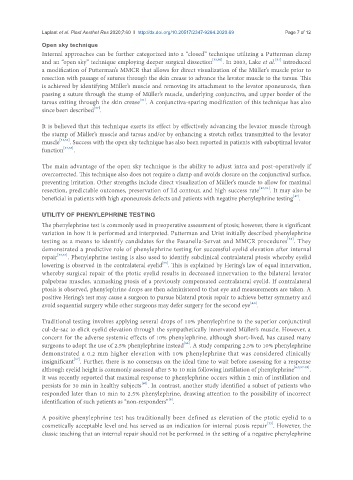Page 707 - Read Online
P. 707
Laplant et al. Plast Aesthet Res 2020;7:60 I http://dx.doi.org/10.20517/2347-9264.2020.69 Page 7 of 12
Open sky technique
Internal approaches can be further categorized into a “closed” technique utilizing a Putterman clamp
[51]
and an “open sky” technique employing deeper surgical dissection [33,50] . In 2003, Lake et al. introduced
a modification of Putterman’s MMCR that allows for direct visualization of the Müller’s muscle prior to
resection with passage of sutures through the skin crease to advance the levator muscle to the tarsus. This
is achieved by identifying Müller’s muscle and removing its attachment to the levator aponeurosis, then
passing a suture through the stump of Müller’s muscle, underlying conjunctiva, and upper border of the
[51]
tarsus exiting through the skin crease . A conjunctiva-sparing modification of this technique has also
[37]
since been described .
It is believed that this technique exerts its effect by effectively advancing the levator muscle through
the stump of Müller’s muscle and tarsus and/or by enhancing a stretch reflex transmitted to the levator
muscle [51,52] . Success with the open sky technique has also been reported in patients with suboptimal levator
function [47,53] .
The main advantage of the open sky technique is the ability to adjust intra and post-operatively if
overcorrected. This technique also does not require a clamp and avoids closure on the conjunctival surface,
preventing irritation. Other strengths include direct visualization of Müller’s muscle to allow for maximal
resection, predictable outcomes, preservation of lid contour, and high success rate [47,51] . It may also be
[47]
beneficial in patients with high aponeurosis defects and patients with negative phenylephrine testing .
UTILITY OF PHENYLEPHRINE TESTING
The phenylephrine test is commonly used in preoperative assessment of ptosis; however, there is significant
variation in how it is performed and interpreted. Putterman and Urist initially described phenylephrine
testing as a means to identify candidates for the Fasanella-Servat and MMCR procedures . They
[33]
demonstrated a predictive role of phenylephrine testing for successful eyelid elevation after internal
repair [33,54] . Phenylephrine testing is also used to identify subclinical contralateral ptosis whereby eyelid
[55]
lowering is observed in the contralateral eyelid . This is explained by Hering’s law of equal innervation,
whereby surgical repair of the ptotic eyelid results in decreased innervation to the bilateral levator
palpebrae muscles, unmasking ptosis of a previously compensated contralateral eyelid. If contralateral
ptosis is observed, phenylephrine drops are then administered to that eye and measurements are taken. A
positive Hering’s test may cause a surgeon to pursue bilateral ptosis repair to achieve better symmetry and
[4,6]
avoid sequential surgery while other surgeons may defer surgery for the second eye .
Traditional testing involves applying several drops of 10% phenylephrine to the superior conjunctival
cul-de-sac to elicit eyelid elevation through the sympathetically innervated Müller’s muscle. However, a
concern for the adverse systemic effects of 10% phenylephrine, although short-lived, has caused many
[56]
surgeons to adopt the use of 2.5% phenylephrine instead . A study comparing 2.5% to 10% phenylephrine
demonstrated a 0.2 mm higher elevation with 10% phenylephrine that was considered clinically
[57]
insignificant . Further, there is no consensus on the ideal time to wait before assessing for a response
although eyelid height is commonly assessed after 5 to 10 min following instillation of phenylephrine [6,7,57-59] .
It was recently reported that maximal response to phenylephrine occurs within 2 min of instillation and
persists for 30 min in healthy subjects . In contrast, another study identified a subset of patients who
[60]
responded later than 10 min to 2.5% phenylephrine, drawing attention to the possibility of incorrect
identification of such patients as “non-responders” .
[6]
A positive phenylephrine test has traditionally been defined as elevation of the ptotic eyelid to a
[33]
cosmetically acceptable level and has served as an indication for internal ptosis repair . However, the
classic teaching that an internal repair should not be performed in the setting of a negative phenylephrine

